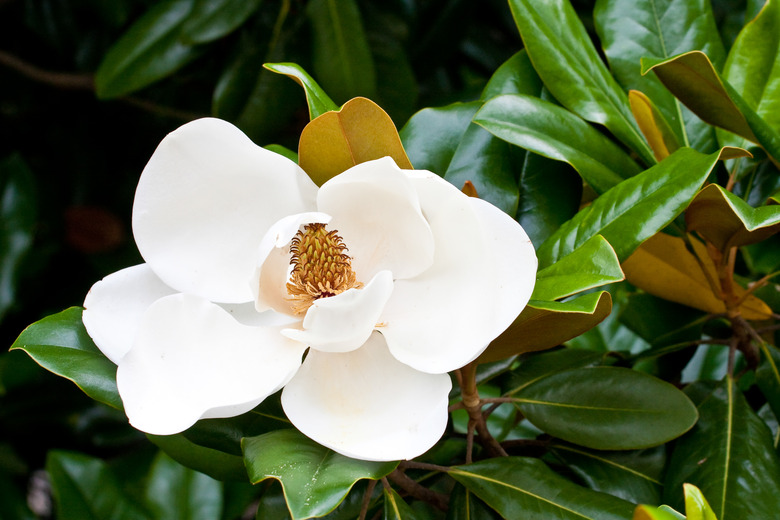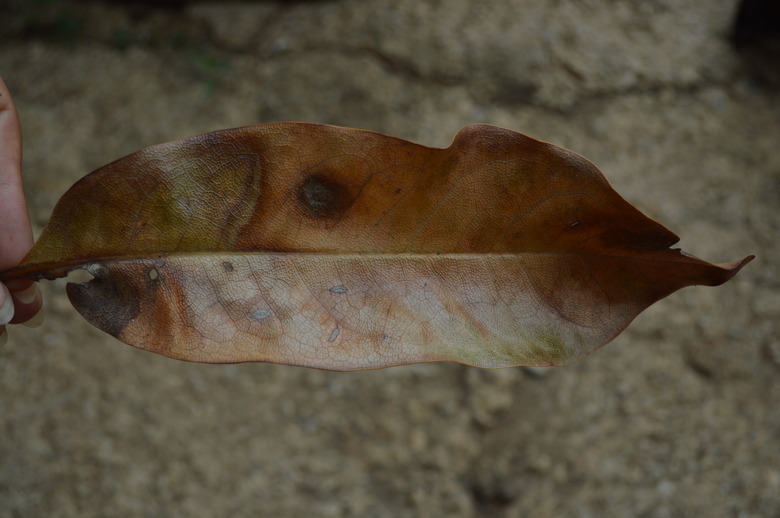Southern Magnolia Tree Diseases
Southern magnolia (Magnolia grandiflora; USDA plant hardiness zones 6 to 10) is a stately ornamental tree with huge, showy, saucer-shaped flowers that are intoxicatingly fragrant.
Although this tree is susceptible to some diseases, it doesn't often die from them and generally doesn't require chemicals to control them. Bacterial blight magnolia diseases; fungus on magnolia trees, which can cause black spots on the foliage; and cankers are among the potential diseases that can infect your magnolia.
Verticillium Wilt Disease
Verticillium wilt disease is caused by a fungal pathogen (Verticillium dahliae) that invades the tree's vascular system, which is responsible for the transportation of water and nutrients. Some branches may die because they're literally starved of nutrition as the disease progresses.
Because the vascular system runs along the interior of the trunk and branches, you won't notice the onset of symptoms, which include a brown discoloration of normally healthy, green tissue inside the branches. Look for external symptoms, such as yellowing or browning foliage followed by dying shoots and branches, which often occur on one side of the tree.
Treatment
Although it's possible that verticillium wilt can kill a Southern magnolia, especially a tree that's already stressed, generally it's not fatal. Dead branches should be pruned out. Not just because they're unsightly and can cause the disease to spread, but also because they pose a hazard if they fall from a tree.
The mature height of Southern magnolia—potentially up to 80 feet—makes pruning a prohibitive task for homeowners. Calling a certified arborist is the best option for managing this disease.
Magnolia Leaf Spot Diseases
Black spots on magnolia leaves are telltale symptoms of different diseases, which may be caused by bacterial, fungal or algal pathogens. Symptoms of algal leaf spot, caused by the fungal pathogen Cephaleuros virescens, begin with green spots or fuzzy colonies on the leaves.
As the disease progresses, these spots turn reddish-brown. Other leaf spot diseases may progress from brown spots to brown patches on the leaves.
Treatment
The best way to prevent leaf spot diseases on Southern magnolia is to keep the tree healthy by making sure it gets enough water and fertilizing it according to soil-test recommendations. It's also important to rake up leaves and other debris from around the tree since fungal pathogens, which are too small to be seen, live in this debris.
Warning
Due to the massive height of mature Southern magnolias—potentially up to 80 feet—pruning projects for verticillium wilt, bacterial blight or canker are often best carried out by certified arborists.
Bacterial Blight Magnolia Disease
Rainy springs provide the perfect environment for bacterial blight magnolia disease to prosper. Commonly caused by the pathogen Pseudomonas syringae, bacterial blight can affect a magnolia's blossoms as well as its leaves by causing large, irregular, brownish-black spots on the flowers and foliage. This disease may also cause the tips of stems to die.
Treatment
During a dry season, prune out the infected growth and dispose of it. This is another pruning task that requires a certified arborist to perform, both for the skill needed as well as for the equipment to reach the tall branches of a mature tree.
Magnolia Canker Disease
If you notice branches with dead leaves on your Southern magnolia tree, look a little closer at the branches. If you see areas that are swollen or sunken, discolored or oozing a dark resin-looking substance, canker disease is the likely culprit.
As the cankers girdle twigs and branches, they cut off the flow of water and nutrients, and the branches die.
Treatment
Cankers can be pruned out by cutting infected branches back at least 6 inches beyond the canker (toward the tree) into healthy growth. It's another job for a certified arborist, who has the expertise as well as the equipment to perform this task.
References
- University of Florida IFAS Extension: Magnolia grandiflora: Southern Magnolia
- University of California, Statewide Integrated Pest Management Program: Magnolia – Magnolia spp.
- University of California, Statewide Integrated Pest Management Program: Verticillium Wilt – Verticillium spp.
- Mississippi State University Extension: Algal Leaf Spot of Southern Magnolia
- North Carolina Cooperative Extension: Pest Alert – Canker Disease on Southern Magnolia

